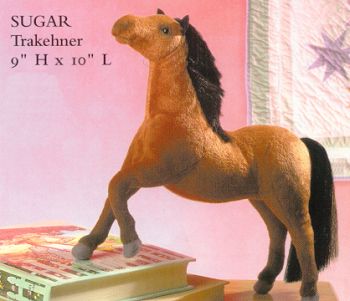|
|
So the first step in getting a horse moving backwards is to move
his head to one side or the other
Teaching your Horse to Back
by Ron Meredith
When you are trying to get a horse's attention, the first thing
you go for is his ears. Once an ear swivels in your direction,
you've got his attention. It may take a little longer before he
turns and faces you or before he walks up to you. But those
bigger movements start with that little tiny movement of his ear.
The same principle applies to teaching your horse to back up. A
lot of people make the mistake of going after the big moves
before they've gotten the smaller ones. All it takes to back a
horse is just the beginning of a movement backwards. That tiny
bit of motion gets a little momentum started that eventually
builds to the bigger movement you're after.
Backing is an illogical movement for horses. It is not a natural
defense or play maneuver. The horse backs by moving its legs in
diagonal pairs, just like it does at the trot. So it has to shift
its weight from side to side in order to back. The horse that is
backing properly does not squat on his hindquarters or get
dragged backwards by the pressure of the halter or the bit. The
rider must apply alternate side-to-side pressures to ask the
horse to shift its weight from side to side in order to back.
The horse's front legs support its head and neck. The head acts
like a weight at the end of a lever. When the weight of the head
shifts sideways, that movement gets transferred to the front
legs. As the head shifts just a little to one side, the horse
shifts more weight to the front foot on that side to maintain his
balance. If the head shifts a little farther to that side, the
horse continues to shift his balance a little more and and you
begin to get the feeling of wanting to move the foot that's not
carrying very much weight anymore. Now you've got a tiny bit of
momentum started that you can build on.
So the first step in getting a horse moving backwards is to move
his head to one side or the other. Pulling straight ahead or
pushing straight back doesn't create the need to shift his weight
from one foot to the other, doesn't create any feeling of
movement, and doesn't get any momentum going.
Use a corridor of aids to help the horse get a feel of the
direction that's open for him to move. Heed the horse along a
wall or fence up into a corner where it's horse logical to stop.
Turn your primary line onto his secondary or neutral line to ask
him to stop. Scratch and groom a little to show him he responded
correctly. Now turn so you're standing at the horse's shoulder
facing backwards.
Check to see which of the horse's front feet is a little farther
forward and which one is a little farther behind. The foot that's
a little farther forward is the first one you are going to ask
him to move back because he already has less weight on it to
start with.
Shift the horse's head toward the foot that's farther behind with
a little tug. Don't hold the horse's head there, just ask him to
shift a little more of his weight onto that foot. At the same
time, reach over with the butt of your whip and put pressure on
the shoulder above the foot that's a little farther forward. Hold
the pressure until the horse moves back. Shift his head a little
farther if you need to but don't increase the pressure on his
shoulder. Just leave it there until the horse moves and then
allow him to move away from the pressure. That front foot moving
back puts pressure on the diagonal hind and the horse will
eventually move it back, too. Now shift the horse's head to the
other side and apply pressure to the other shoulder in the same
sequence to move the other diagonal pair of legs.
In the beginning, it's not important how far the horse backs.
Just ask for one step, one foot at a time. Remember, this is not
a logical movement to the horse. So just ask for a small piece at
first. If the horse is really having a problem with stepping
backwards, just quietly return to heeding him forward and in
circles and then go back to the fence or the wall and try another
single step backwards. Eventually, the horse's understanding will
increase.
Everything you do with a horse should start with a command or
pressure that says "prepare" or get ready to do something
followed by a pressure that says "execute" or now's the correct
time to do it. Bringing the horse's head to the side is the
command of preparation to back. Putting pressure on his shoulder
is the command of execution to move a foot. Later, under saddle,
you will use bit pressures to shift the horse's head and your
weight and leg pressures will replace the shoulder pressures.
As the horse's understanding of what the pressure mean increases,
then the speed with which he responds to them will increase. You
will be able to keep the pressure up longer so he takes more
steps and backs a greater distance. You will be able to switch
the pressures from side to side more quickly to influence the
cadence of his steps. And you will be able to influence the
length of the horse's strides by how long you keep pressure on it
before releasing.
Ron Meredith has refined his "horse logical" methods for
communicating with equines for over 30 years as president of:
http://www.meredithmanor.com
Plush Stuffed Horses

|